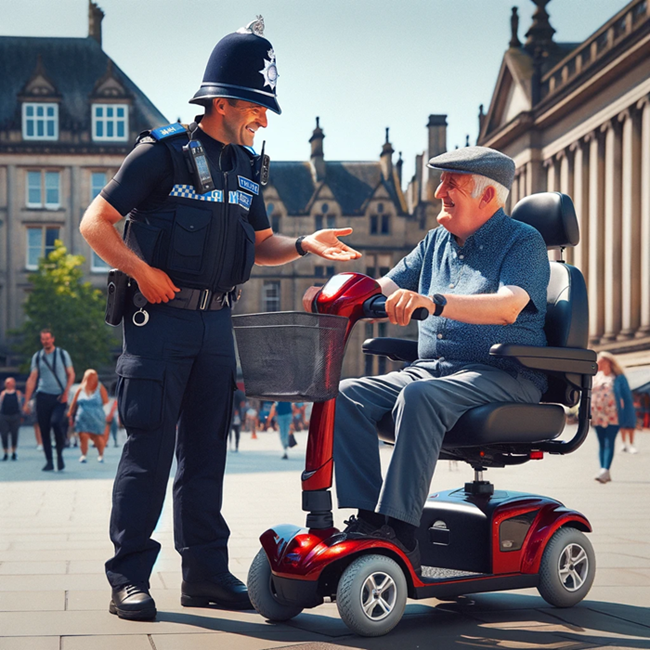Do I Need Insurance & Driving License for a Mobility Scooter?

Insurance Requirements
In the UK, cruising around on a mobility scooter doesn’t tie you up in too much red tape. Here’s the lowdown: you don’t need insurance to ride one on the road. Yep, you read that right! However, it’s not a bad idea to consider getting some coverage to protect yourself and your scooter. You never know when an unexpected bump might come your way!
You can be pretty savvy with your mobility scooter by adding it to your home and contents insurance policy for that extra layer of protection against fire and theft. It’s like giving your scooter a cozy security blanket, making sure it’s covered just in case something unexpected happens.
Just a heads up, though – it’s a good idea to have a chat with your insurance provider to get the lowdown on the specifics. Policies can vary, and you’ll want to make sure your scooter is covered in the way you expect. Ask about any conditions or exclusions that might apply, like if the scooter needs to be stored in a locked garage or if there are any specific security measures you need to take.
Adding your mobility scooter to your home insurance could be a smart move to save on costs and keep things simple, especially if you’re already covering other valuables. Just make sure you’re clear on the details, and you’ll be all set to enjoy your rides with a little extra peace of mind.
Lastly, while insurance isn’t mandatory, it’s worth considering for peace of mind. Motorised vehicle insurance policies can cover you for theft, accidental damage, and third-party liability, so if you accidentally clip someone’s heels or bump into a parked car, you’re covered.
Legal Age
As for age, if you’re planning to hop on a Class 3 mobility scooter – the kind that’s allowed on the road and can buzz up to 8mph – you’ve got to be at least 14 years old. Youngsters dreaming of their first set of powered wheels need to wait a bit, I’m afraid.
Do I Need a Driving License
No you don’t need a license to drive these scooters, nor do you have to pass any driving tests. It’s pretty straightforward: if you meet the age requirement and have a scooter that’s road-legal, you’re good to go. Of course, sticking to the rules of the road and being mindful of other road users is a must.
Even though you don’t need a driver’s license, there are a few things to keep in mind to ensure you’re all set and legal. For starters, if you’re using a Class 3 mobility scooter, it must be registered with the DVLA. You’ll get a special registration document for it, but unlike cars, you don’t have to display a number plate.
When you’re out and about, remember that Class 3 scooters can indeed go on the road, but there are places you might want to avoid, like motorways and cycle lanes. Also, it’s good practice to use the pavement or footpath if there’s one available and it’s safe to do so. When you’re on the pavement, though, you have to cap your speed at 4mph to keep things safe for everyone.
If you’re planning to ride your scooter on the road. Make sure you’ve got lights, indicators, and a horn to help you communicate with other road users.
Get to Know Your Scooter
Before you hit the road (or pavement), take some time to get familiar with your mobility scooter. Understand how it works, from accelerating and braking to using the lights and indicators. Practicing in a safe, quiet area can boost your confidence and help you handle the scooter better in different situations.
Plan Your Routes
Think about where you’re going and the best way to get there. Opt for routes with smooth, flat surfaces and avoid areas with lots of steps or steep inclines if possible. Check out if there are any scooter-friendly paths or facilities along the way. Planning ahead can make your journeys more enjoyable and less stressful.
Battery Life is Key
Keep an eye on your scooter’s battery life and make sure it’s fully charged before you go out, especially if you’re planning a longer trip. It’s a good idea to know the range of your scooter and plan your journeys within that limit. Carrying a charger with you might be handy if you’re out for the day and know there’ll be a place to top up if needed.
Stay Visible and Alert
Always be aware of your surroundings and make sure others can see you, especially in low light or bad weather. Use your lights and wear bright or reflective clothing. Being alert and aware can help you avoid accidents and navigate safely around pedestrians, vehicles, and other obstacles.
Know Your Rights and Responsibilities
While mobility scooters offer greater freedom, it’s important to be a responsible rider. Follow the rules of the road, respect pedestrian areas, and be courteous to others. If you’re ever unsure about where you can and can’t go with your scooter or any specific regulations, a quick check online or a call to your local council can provide clarity.
Maintenance Matters
Regular checks and maintenance can keep your scooter in top shape. This includes checking the tires, brakes, and battery, as well as arranging for professional servicing when needed. A well-maintained scooter is safer and more reliable, giving you peace of mind while you’re out and about.
Conclusion
Riding a mobility scooter can be a fantastic way to maintain independence and get around, just make sure you’re up to speed with these guidelines and tips to keep your rides smooth and legal. Stay safe and enjoy the freedom your scooter brings!




